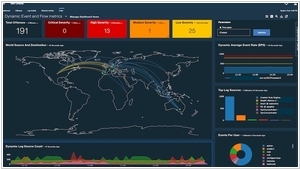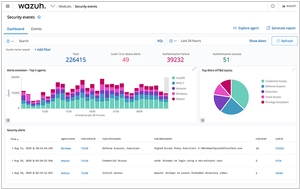IBM QRadar vs Wazuh
August 06, 2023 | Author: Michael Stromann
See also:
Top 10 SIEM software
Top 10 SIEM software
IBM QRadar and Wazuh are both powerful cybersecurity solutions, but they differ significantly in their scope, capabilities, and deployment models. IBM QRadar is an enterprise-grade security information and event management (SIEM) platform that provides comprehensive visibility into an organization's security landscape. It excels in collecting, correlating, and analyzing log data from various sources, enabling real-time threat detection and advanced analytics. QRadar offers a wide range of security features, including user behavior analytics, network traffic analysis, and integration with threat intelligence feeds. Its scalability and robust reporting capabilities make it suitable for large organizations with complex IT environments.
On the other hand, Wazuh is an open-source security monitoring platform that focuses on host-based intrusion detection and log analysis. It is designed to detect and respond to security threats at the endpoint level. Wazuh leverages the power of OSSEC (Open Source Host-based Intrusion Detection System), providing real-time analysis of security alerts generated by log data and system events. While Wazuh may not offer the breadth of features found in IBM QRadar, it provides a cost-effective option for organizations seeking an open-source, extensible solution with the flexibility to customize and integrate with their existing security stack.
Another key difference lies in their deployment models. IBM QRadar is a commercial, on-premises, or cloud-based SIEM platform, offering a managed security service option as well. It is suitable for large enterprises that require dedicated hardware and robust infrastructure. In contrast, Wazuh is primarily an on-premises solution that can also be deployed in the cloud. As an open-source platform, it offers more flexibility in terms of deployment and customization but may require more effort and expertise to set up and maintain compared to IBM QRadar's managed services.
See also: Top 10 SIEM software
On the other hand, Wazuh is an open-source security monitoring platform that focuses on host-based intrusion detection and log analysis. It is designed to detect and respond to security threats at the endpoint level. Wazuh leverages the power of OSSEC (Open Source Host-based Intrusion Detection System), providing real-time analysis of security alerts generated by log data and system events. While Wazuh may not offer the breadth of features found in IBM QRadar, it provides a cost-effective option for organizations seeking an open-source, extensible solution with the flexibility to customize and integrate with their existing security stack.
Another key difference lies in their deployment models. IBM QRadar is a commercial, on-premises, or cloud-based SIEM platform, offering a managed security service option as well. It is suitable for large enterprises that require dedicated hardware and robust infrastructure. In contrast, Wazuh is primarily an on-premises solution that can also be deployed in the cloud. As an open-source platform, it offers more flexibility in terms of deployment and customization but may require more effort and expertise to set up and maintain compared to IBM QRadar's managed services.
See also: Top 10 SIEM software





